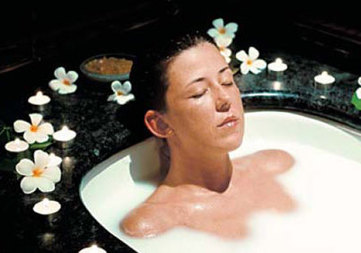The names of some European spas - Bad Salzdetfurth, Bad Salzungen oder Bad Salzuflen -indicate that salt is an important part of the spa's program.
Visitors to those European spas and others immerse themselves in healing, briny water containing a minimum of 1.45 percent salt. The salt springs on which the spas are built are found nearly everywhere in Germany.
"Developing them is very expensive and so is using them," says Professor Karl-Ludwig Resch of the German Institute for Health Research in Bad Elster. Thus, there's little wonder that for centuries salt commonly has been known as "white gold".
|

|
|
The names of some European spas - Bad Salzdetfurth, Bad Salzungen oder Bad Salzuflen - indicate that salt is an important part of the spa's program.[Agencies via China Daily] |
Salt mining was in many places the basis for prosperity before the existence of the spa and recreation operations were built near salt springs, says Werner Schmidt of Hohenlohe, a district in northern Baden-Wuerttemberg, and a spokesman for a tourism company.
"Beyond its use in spas, salt no longer plays an economic role," says Schmidt. But recreational enthusiasts follow the tracks of salt's story when they travel the "Salt and Brine Wellness Route" in the Swabian Alb region northward to between the Neckar and Hohenlohe districts where there are abundant underground salt deposits.
Bathing in salt water can lift one's well-being. Water containing?three percent salt gives the body buoyancy, allowing the muscles to relax. The higher the salt content in the water, the greater the relaxation.
"As opposed to meditation, you don't need a concentration technique," says Resch. A good floating sensation can be achieved in water that is?seven percent salt, and near weightlessness can be felt in water that is 15 percent salt. While bathing in water with these high concentrations of salt, the automatic nervous system cuts back and the person is fully relaxed.
Professor Christoph Gutenbrunner of a Hanover medical school, however, is critical of the notion - promulgated in many places - that salt baths are good for one's well-being.
"We don't know whether the salt concentrations of two-to-three percent in the wellness area have a relevant effect on overall health," says Gutenbrunner.
Salt is first and foremost a therapeutic agent that, with regular use, helps against skin problems such as psoriasis, he says. To treat such skin problems the salt concentration should be?six percent and the bath should last about 20 minutes.
Salt extracts fluid from the skin through osmotically stimulating water, which in turn has an effect on the immune system of a psoriasis patient, says Professor Helmut Pratzel, who has worked for many years in the Institute for Medical Balneology and Climatology at the University of Munich. The immune system's reaction is to send messengers to the entire organism, activating the body's self-healing power.
A second area in which salt baths are applied is degenerative conditions such as arthrosis in the hip, knee or lumbar region. Salt is also used in the treatment of rheumatic illnesses, although people with rheumatism may go into water only when they are not in acute phases of inflammation, warns Gutenbrunner.
|

|
|
The names of some European spas - Bad Salzdetfurth, Bad Salzungen oder Bad Salzuflen - indicate that salt is an important part of the spa's program. [Agencies via China Daily] |
"Salt is relatively taxing because the stimulation that it releases can heavily strain the body when it is in an acute stage of an illness," he says. Outside an acute flare up, the stimulation can lead to clear improvements and have a positive effect, for example, on the patient's sensitivity to pain.
Respiratory problems also can be treated with salt water. For that application, salt water is turned into fine aerosol droplets. This occurred naturally over the brushwood at salt works - a relic of industrial salt processing, which still exist in Bad Reichenhall in southeastern Germany or Bad Sooden-Allendorf in Hesse.
There also are salt-drinking spas, which are barely still accepted. They were once visited by people who were deficient in minerals, but Resch says today they serve no medicinal purpose. And when it's not absolutely necessary, no one voluntarily drinks salt water.
There's nothing wrong with combining a salt water treatment with going into a sauna, says Hans-Juergen Gensow, a spokesman for Germany's Sauna Union in Bielefeld. He recommends first swimming in a thermal bath, then taking a break to allow circulation to return to normal. Afterward, go into the sauna.
"But please don't spend a half hour in thermal water, and then follow it with an extensive amount of time in the sauna sweating," Gensow says. Also, bathers should not switch back and forth from thermal bath to sauna without a break in between.
(Agencies via China Daily October 9, 2008)